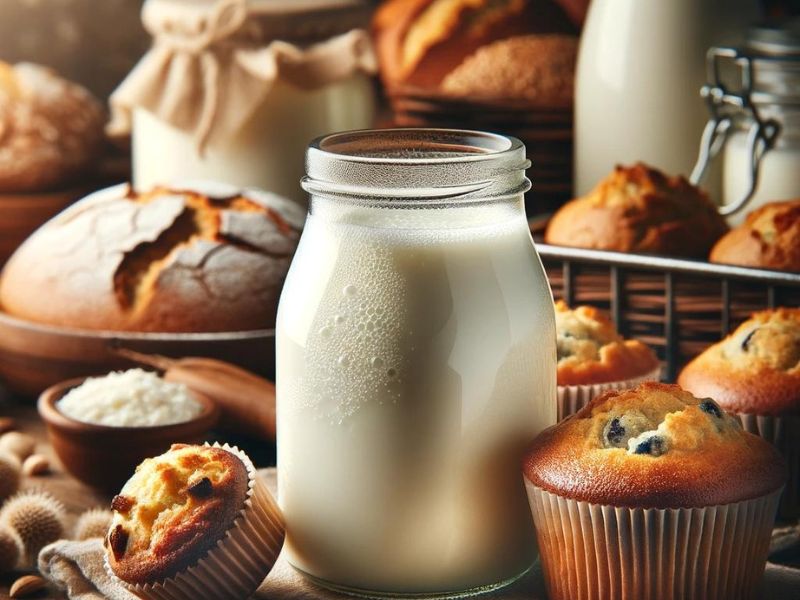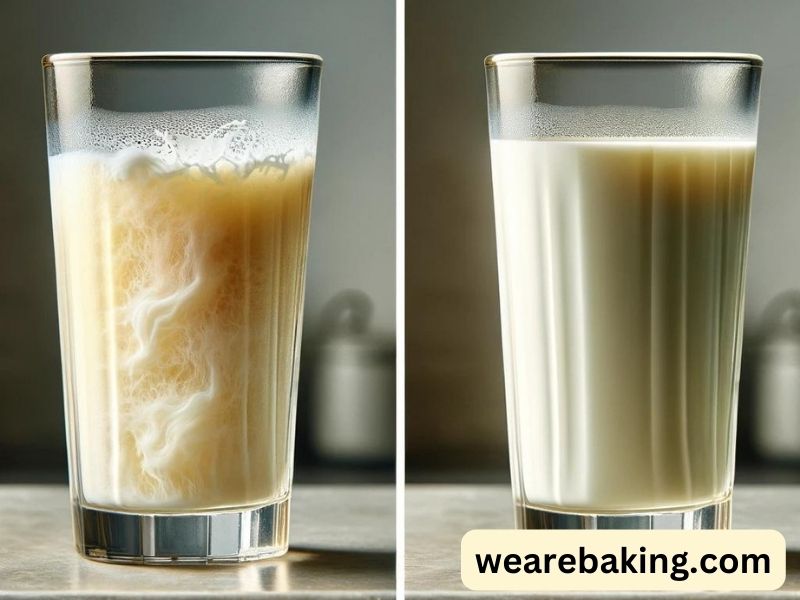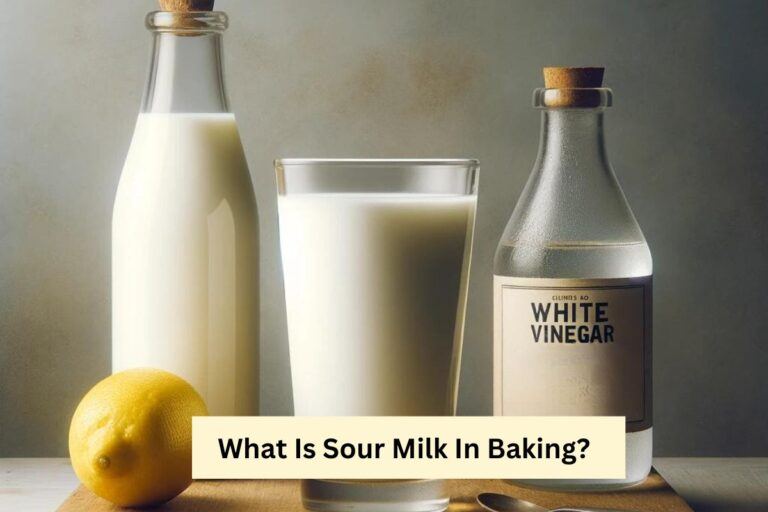Sour milk refers to milk that has been intentionally soured by adding an acid to enhance its flavor. It should not be confused with spoiled milk. Recipes call for sour milk because its tangy acidity can help baked goods like pancakes, waffles, cakes, and quick breads rise properly while also giving them a pleasant, mild sourness.
What Makes Sour Milk Sour?
In baking, sour milk isn’t just milk gone bad (phew!). It has a special sourness that comes from two main sources.
The Good Guys
Sometimes, friendly bacteria like Lactobacillus get added to milk. The Lactobacillus munch on the milk’s natural sugars, turning them into lactic acid. This acid gives sour milk its signature tangy flavor and tenderizes baked goods, making them moist and fluffy. Examples are buttermilk, kefir, sour cream, or yogurt.
The Shortcut
Need sour milk in a pinch? No problem! You can mix a little lemon juice or vinegar into regular milk. This acid reacts with the milk proteins, creating a similar tangy bite without the bacteria. It’s a handy trick for baking, but keep in mind it won’t have the same complex flavors or benefits as real fermented sour milk.
So, whether it’s the good guys working their magic or a quick vinegar trick, the sourness in milk adds a delicious twist and helps create amazing baked treats.
Remember, sour milk, due to natural spoilage (off smell, lumpy texture), is not safe to use in baking. Choose the good guys or the vinegar shortcut for delicious results!
🍞 pH Levels and Their Effects in Baking 🧁 |
||
|---|---|---|
| Dairy Product | pH Level | Effect in Baking |
| Whole Milk, 2% Reduced Fat Milk, 1% Lowfat Milk, Skim Milk | 6.7 | Neutral, balances flavors and textures |
| Cream, Half and Half | 6.5 | Slightly acidic, adds richness and creaminess |
| Sour Cream | 4.5 | Acidic, enhances tenderness and leavening |
| Buttermilk | 4.2 | Acidic, ideal for fluffy pancakes and biscuits |
| Plain Yogurt | 4.0 | Acidic, adds moisture and activates baking soda |
| Greek Yogurt | 3.5 | Highly acidic, great for tenderizing and adding tang |
| Brought to You by wearebaking.com 🍰 | ||
Using Sour Milk in Baking

You’ll often see sour milk used in batter-based baked goods like pancakes, waffles, biscuits, muffins, quick breads, and some cakes. The mild acidity helps activate baking soda or powder for lift and rise. For example, sour milk is a key ingredient in recipes for fluffy pancakes and buttermilk biscuits where you want a delicate, tender texture.
Another reason recipes call for sour milk is its subtle tangy flavor. It brings a twang that complements baked goods like cornbread, banana bread, coffee cake, and chocolate cake. The sourness often enhances the other flavors. For instance, it brings out the sweetness in muffins and heightens the aromatic qualities of spices. Just a splash can make flavors shine.
Sour milk also helps retain moisture and keep quick breads and cakes tender and fluffy long after baking. Its acidic pH weakens gluten strands, preventing toughness. So while you can substitute regular milk in some cases, you’ll miss out on that moisture, rise, and bright flavor only sour milk can provide.
🎂 Benefits of Using Sour Milk in Baking 🍰 |
|
|---|---|
| Enhanced Flavor | Adds a subtle tanginess that complements sweet and savory baked goods alike. |
| Improved Texture | Tenderizes gluten, making cakes, breads, and pancakes softer and fluffier. |
| Better Moisture Retention | Helps baked goods stay moist and fresh for longer periods. |
| Natural Leavening Agent | The acidity reacts with baking soda or powder to create lift and rise without the need for yeast. |
| Brought to You by wearebaking.com 🍪 | |
Making Sour Milk at Home
For every cup of milk, add 1 tablespoon of vinegar or lemon juice, mix gently, and then let sit for at least 5-10 minutes—no skipping this step! Using the soured milk immediately after mixing would be a complete waste of your time and ingredients. The waiting period is necessary to allow the acid time to curdle and ferment the milk, lowering the pH and developing that tangy flavor typical of sour milk. You’ll see the milk change texture and appear slightly thickened when it’s ready. Resist overmixing once it has soured for the best results.
You can usually substitute soured milk for buttermilk 1:1 in baking recipes. For instance, if you need 1 cup of buttermilk, substitute it with 1 cup of sour milk.
I only make enough sour milk that is needed for the recipe I am making. That way, I don’t have extra hanging around that I need to store. Who knows when I will need sour milk again?
Is it Safe or Spoiled?

Safely soured milk starts with fresh milk that you mix an acid into, like lemon juice or vinegar. You let it sit out at room temperature for 10-15 minutes after adding the acid. This careful process creates tangy flavors and thickness without letting dangerous germs grow. Spoiled milk is different – it goes bad when you leave fresh milk out of the refrigerator for too long. It naturally separates into clumps and allows harmful bacteria to grow.
Signs that your milk has spoiled and is no longer safe to use include bad smells like rancid butter, cheese, or rotten eggs coming from the milk. Off-colors like yellowish, grayish, or pinkish hues rather than pure white can also indicate excess bacterial development. Lastly, visible mold, slime formation, or slimy residue on the sides of the container confirms milk is unfit for use.
Frequently Asked Questions
Here are some common questions regarding sour milk
Is sour milk the same as buttermilk?
Not technically. Buttermilk is a cultured milk product made from milk fermented with specific bacteria, while sour milk is just fresh milk that has been manually curdled with acid. However, their flavors and cooking properties are quite similar, which is why sour milk makes an excellent substitute in recipes calling for buttermilk.
What’s the difference between sour milk and spoiled milk?
Spoiled milk has gone truly rancid, with even more enzymes and bacteria that provide a foul rotting smell. The harmless bacteria in sour milk just produces acid without offensive or potentially dangerous microbes. Sour milk smells pleasantly tangy.
Why do recipes call for sour milk?
Recipes use sour milk for its acidity. The acid interacts with leaveners like baking powder and soda to make batters rise and baked goods tender rather than tough. Sour milk also adds moisture for lightness and subtle tangy flavors that enhance other tastes.
Is it better to use lemon juice or vinegar to make sour milk?
Good news – either works wonderfully! Lemon juice imparts a very subtle extra flavor, but plain distilled white vinegar truly leaves no vinegar essence. Use whatever you have handy to quickly transform milk and unlock all that sour power!
Key Takeaways
- Sour milk refers to milk that has been intentionally soured with added acid to enhance tangy flavor. It’s different from spoiled rotten milk.
- There are two main ways milk sours – from lactic acid bacteria fermenting natural sugars or by directly adding an acid like lemon juice or vinegar. Either way, acidity develops.
- Recipes use sour dairy products like buttermilk, yogurt, and soured milk for their acidity to help batters rise, keep textures tender, add moisture, and brighten other flavors.
- Sour milk can be easily and safely made at home by stirring an acid into fresh milk and allowing it to sit for 5-10 minutes before using in baking recipes.
- Properly soured milk has a pleasant tangy flavor and thickened texture, unlike spoiled milk, which smells rancid, changes color/appearance, and can contain dangerous bacteria.
- Sour milk is a versatile baking ingredient that can substitute for buttermilk, improve lift and texture, prevent denseness, retain moisture, and amplify sweetness and spice flavors across diverse goodies from pancakes to cakes.
Have you made and used sour milk in your baking? Please leave me a comment below
And As Always
Keep On Baking!
Taianne
Share the Love

I’m Taianne, the owner and operator behind We Are Baking. Baking my first cake at age 11 hooked me on creating sweet treats. Though my interest faded during childhood, it was rekindled when I married my apple pie-loving husband. I love trying new recipes, tweaking classics, and helping others learn the science and art of baking. I started We Are Baking to share tips, tricks, and favorite recipes I’ve discovered over the years. When not in the kitchen, I enjoy spending time with family and friends. My goal is to inspire others to embrace their creativity through baking. Feel free to contact me with any questions!
Taianne@wearebaking.com

